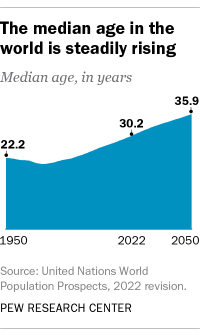pewresearch.org – Globally, the number of males has exceeded the number of females since the mid-1960s. But by 2050, the worldwide sex ratio is expected to even out, according to recently released population projections from the United Nations.
As of 2021, there were about 44 million more males than females in the global population. But that difference is expected to disappear as a result of several different demographic trends.
In the coming decades, the world population is expected to age due to a combination of declining fertility (a smaller share of the world’s population will be young) and people living longer (a larger share of the world’s population will be old). Between 1950 and 2021, the median global age rose from 22 to 30. By 2050, the UN projects the median global age will surpass 35.

How we did this
When a large share of a population is young, it tends to skew male because more boys are born than girls. This pattern is exacerbated in countries where sex-selective abortions and female infanticide contribute to imbalanced sex ratios at birth. In 2021, the global sex ratio at birth was 106 male births per 100 female births. Gender inequalities also make girls and women more vulnerable to poor health, often putting them at higher risk of death, including from complications during and following pregnancy and childbirth.
However, in most countries, females have lower mortality rates after birth and live longer than males, on average. Higher male mortality has been associated with behavioral factors and genetic differences. In addition, more males than females have died due to the COVID-19 pandemic.
Because of these patterns, females outnumber males at older ages. In 2021, women comprised 56% of the global population ages 65 and older, including 59% in Europe and Northern America. Their share of the global 65-and-older population is projected to be 54% by 2050. As populations age, they are more likely to become majority female.
Not only does the UN project parity between the sexes by 2050, it projects that females will begin to outnumber males in the decades after 2050.
Sex ratios vary widely
The countries with the biggest male-to-female ratios today are Qatar (266 males per 100 females), the United Arab Emirates (228) and Bahrain (164). In several Persian Gulf countries, these wide sex imbalances are primarily due to large immigrant populations of largely male temporary workers. For example, according to UN estimates, 79% of Qatar’s 2019 population was born elsewhere, and among the foreign-born population, 83% were male.

In many former Soviet Union republics, the reverse is true. The former USSR has been predominantly female since at least World War II, when millions of men died in battle. For example, in the territory that is now Russia, there were just 77 males per 100 females in 1950. That number rose steadily in subsequent decades, climbing to 88 by 1995 before starting to decline again. Several other countries from the former Soviet Union have seen similar patterns, and in 2021, they accounted for six of the 10 nations with the highest ratio of females to males.
Even within the same country, sex ratios can differ widely by age. For example, Armenia is the most heavily skewed country toward females (82 males per 100 females), but there are still more newborn boys than girls. In fact, for every 100 girls born in Armenia, 110 are boys – the world’s sixth starkest sex ratio at birth in favor of boys.
Other places with overall sex ratios that skew heavily female include Guadeloupe, Martinique, Hong Kong and the U.S. Virgin Islands.
The United States has had more females than males since 1946, according to the U.S. Census Bureau. In 2021, the population sex ratio in the U.S. was 98 males per 100 females. By 2050, it is expected to be 99.
The number of majority-male countries will decline by 2050
In 2021, males outnumbered females in 86 countries. That figure is expected to decline to 67 countries by 2050 as an increasing number of majority-female populations emerge.
Within countries where males are expected to continue outnumbering females in 2050, the UN still projects a more balanced sex ratio in the coming decades.
A recent Pew Research Center report took a closer look at the sex ratio at birth in India, specifically. India’s artificially wide ratio of baby boys to baby girls – which arose in the 1970s from the use of prenatal diagnostic technology to facilitate sex-selective abortions – now appears to be narrowing. This follows years of government efforts to curb sex selection, including a ban on prenatal sex tests and a massive advertising campaign urging parents to “save the girl child,” and coincides with broader social changes such as rising education and wealth.
Projections describe how populations will change if their underlying input data are accurate and their assumptions about future trends (e.g., that fertility will decline in high-fertility countries) are correct. However, unexpected events like war, famine and disease may produce different outcomes and may alter the world’s gender balance by causing a greater number of deaths for males or females and by affecting migration trends of individual countries.






